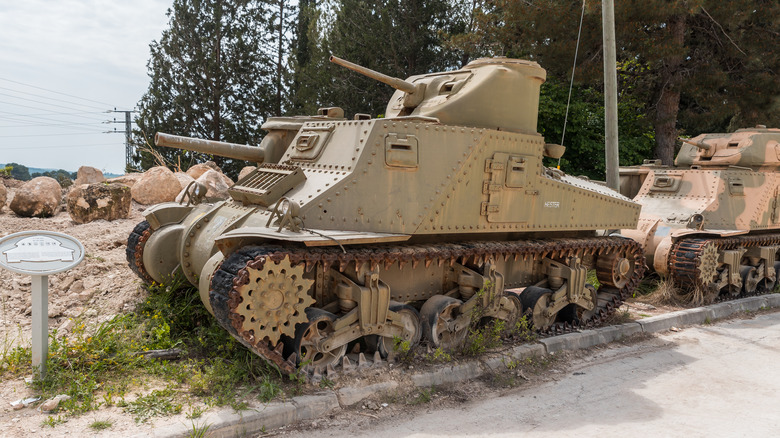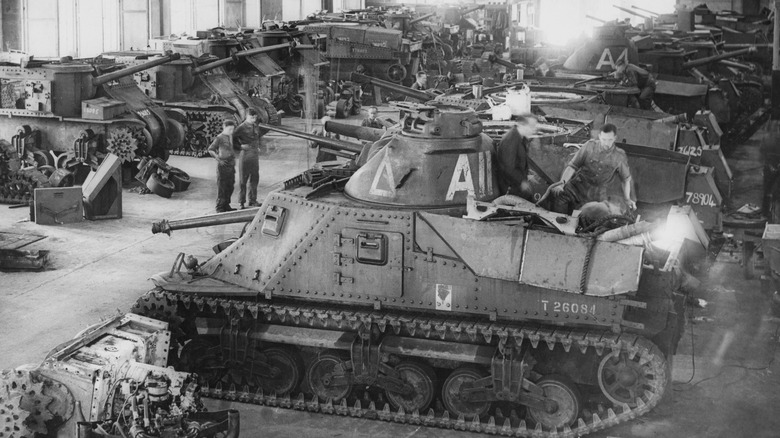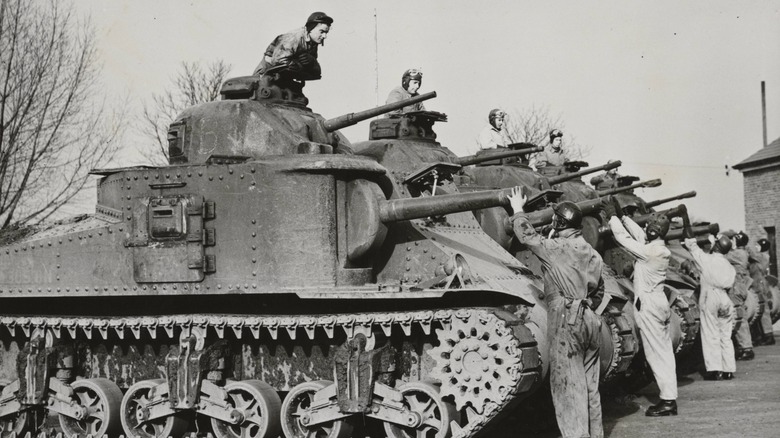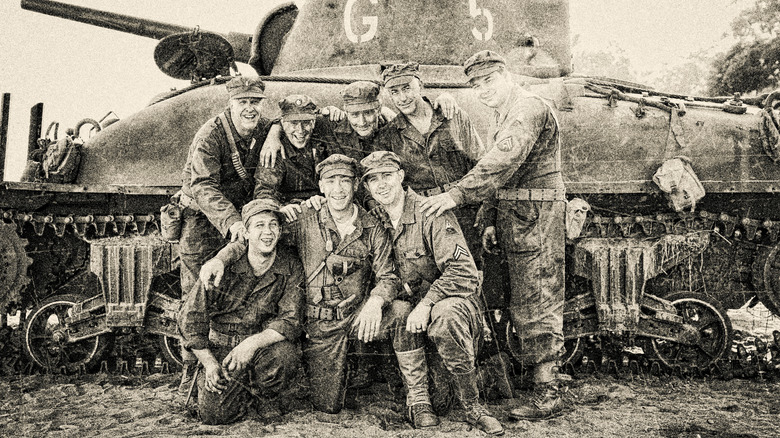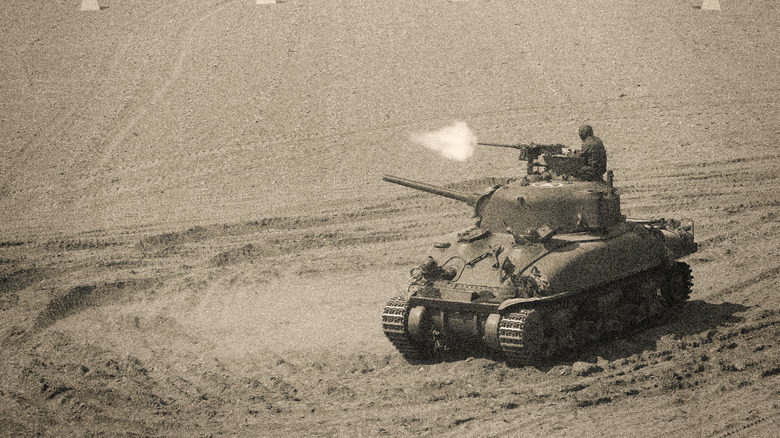Why The M3 Lee/Grant Tank Was The Next Best Thing To The M4 Sherman
Land combat in World War II was dominated by the tank. The role of these hefty vehicles changed somewhat as the war evolved, with new models being manufactured and their weapons and defenses evolving. Some tank designs would become emblematic of the era, with the Allies' M3 and M4 central among them.
Light tanks and medium tanks had ample roles in the conflict, and models of the M3 provided both. The M3 Light Tank, unsurprisingly, was a light tank, also dubbed the Stuart. This model was finished in the United States in 1940 and first saw combat the next year. It boasted extreme strengths, but also had weaknesses expected of a light tank: A supportive recon machine that fell down rather heavily in terms of firepower. It sported a 37mm M6 that one unnamed soldier jokingly summed up thus, according to the National World War II Museum, "popcorn balls thrown by Little Bo Peep would have been just as effective."
Popcorn balls, naturally, weren't up to all of the ghastly combat that the conflict would see, and so something a little more powerful was also introduced. But the M3 Stuart is not to be confused with the M3 Lee. This model was a medium tank, and though it proved impactful, it would be replaced by another model in time. Even so, it served a vital role while its successor was unavailable in significant numbers.
When was the M3 Lee/Grant introduced?
The swift and devastating progress that German forces made across the continent of Europe in the earlier stages of World War II represented a tremendous problem for the Allies: How to maintain a mechanized force large enough to push back. A tank with significant firepower and resilience, which could nonetheless be manufactured relatively easily, would be critical. This would be the M3 Medium Tank, the Lee.
This medium tank's design was completed in April of 1941. It was somewhat improvised from the existing M2, which had similarly proven to be rather inferior to the opposition (that being the Afrika Korps). Variants included the British Army's model, the M3 Grant (which Chris Copson describes in an episode of Tank Chats Reloaded as having "a larger turret and no [machine gun] cupola"), and the US-original M3 Medium Tank or Lee. The latter instead sported "a smaller turret with a large machine gun cupola on top," per Copson.
The priority had been increasing its firepower and resilience, the better to withstand the Axis tanks. Over 6,000 M3s were built during the 16-month period that it was developed. Though it was a curiously-designed machine that would soon be followed by the venerable and long-lived M4 Sherman, it brought quite a lot to the table before the Sherman could be produced in the numbers required.
The capabilities of the M3 Medium Tank
The M3 Lee is a tower of a tank. Its unusual appearance derives from the desire to add the 75mm gun to it, a mighty weapon that was improvised onto its body on a sponson. By doing so, and with the addition of the machine gun and sizable turret on some models, its form could be very tall.
David Fletcher explains in a Tank Chat episode for The Tank Museum that the gun was placed where it was because U.S. engineering. Still rather new to the development of tanks, it could not yet create a turret large enough to support such an armament. Nonetheless, it was a potent weapon capable of launching "high explosive and armor-piercing shot," Fletcher goes on, "and was quite effective by comparison with what had gone before in British service."
The issue was that it wasn't the most practical weapon to use. Despite its power, its velocity problems reduced its capacity to infiltrate heavily-armored targets. With such shells being particularly unwieldy to operate as it was, this was a considerable issue.
Even so, the objective with the M3 Grant/Lee was to provide the Allies with a more potent gun in a better-armored package (its armor was up to 56mm), as quickly and efficiently as could be manufactured. It certainly achieved these things, and by so doing, set the stage for the M4 Sherman.
The M4 Sherman arrives on the scene
It goes without saying that military projects, of varying degrees of secrecy, were constantly underway throughout the war. Progress on them was unpredictable: Some would be completed ahead of schedule, some would run concurrently, and others still wouldn't pan out at all. The iconic M4 Sherman was being produced in early 1942, with its design being finalized the previous year. This meant that it was being prepared at around the same time as the Lee and Grant, but could not be produced at such a rate at the time.
The Sherman was based upon the mechanics of the M3 Grant, with a GAA-V8 Ford engine capable of 500 hp and a speed of around 26 mph. Its machine guns (with which it was equipped in the case of the M4A1 model) were backed up by that same 75mm primary armament, though, in the Sherman, the latter was mounted in the turret and so could be aimed much more freely.
This, then, was the tank that the M3 Grant/Lee would have been the first time around, had the Allies had the time and experience to have made it so.
The Lee/Grant, and Sherman in context
The M4 Sherman also had its shortcomings. The 1943 Sherman Firefly, a model created by installing a 76.2 mm gun, was developed for the sole purpose of allowing it to compete with an emerging generation of more potent German tanks (an area in which it otherwise truly struggled). As befits its medium tank designation, the Sherman was also designed to do a bit of everything, which meant it could be outclassed by more specialized machines.
This very factor, however, also proved to be one of the model's biggest assets. It was easy to maintain and repair, and its manufacture was relatively uncomplicated. This allowed it to be developed in great numbers (upwards of 50,000 in total).
The Sherman wasn't the most powerful tank, the fastest, or the most defensive. It continues to be acclaimed (rather like the M1 Abrams), however, for its adaptability. Its predecessor on which it was heavily based, the Medium M3, was not quite so versatile, but it filled a hole that the Allies desperately needed covered. Without it, there would perhaps have been no Sherman.
